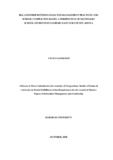| dc.description.abstract | Low secondary school completion rates have been linked to factors such as social-economic and social-cultural characteristic of students, low intrinsic motivation to learn, parental influence and lack of role models in the community among others. However, previous studies in Kenya and specifically in Samburu County have not established links between school management practices and secondary school completion rates. The purpose of this study was to establish the relationship between management practices and secondary school completion rates in Samburu East Sub-county, Kenya. The objective of this study was to investigate the relationship between selected school cultures, selected user education costs, availability of selected instructional resources, selected student motivational practices and selected classroom instruction on secondary school completion rates in Samburu East Sub-county, Kenya. The study adopted descriptive survey research design. The study was guided by influential theory by Finn (1993). The target population was 254 Form Four students derived from 7 secondary schools in Samburu East Sub-county, Kenya. The sample size of the study was 156 form four students who participated in the study as respondents. The 7 schools included in the study were sampled on the basis of the fact that they had student cohorts who sat for Kenya Certificate of Secondary Education examination. Data was collected using questionnaire. Content validity was used to validate the instrument also validity was ensured through expert opinions. Piloting was done and reliability was tested using Pearson Product Moment Correlation. Coefficient value of above 0.7 was obtained therefore, the questionnaire was reliable. Stratified and simple random sampling technique was used to obtain respondents. Data were analyzed using descriptive and inferential statistics. Quantitative data was analyzed using mean, frequencies, percentages and Pearson Correlation Coefficient. The findings were presented in tables. Pearson Correlation Coefficient was used to test the hypothesis at a threshold of 0.5 alpha level. The study established that there exists a positive and significant relationship (r = .472, P=0.000) between school cultures and secondary school completion rates. The study further established that there exists a positive and significant relationship (r = .294, P=0.000) between user student education costs and secondary school completion rates in Samburu East Sub-county. In addition, the study established that there exists a positive and significant relationship (r = .540, P=0.000) between provision of instructional resources and secondary school completion rates in Samburu East Sub-county. The study also established that there exists a positive and significant relationship (r = .544, P=0.000) between student motivational practices and secondary school completion rates in Samburu East Sub-county. Finally, the study established that there exists a negative but significant relationship (r = -0.194, P=0.000) between classroom instructional practices and secondary school completion rates in Samburu East Sub-county. The researcher concluded that there statistically significant relationship between school cultures, user education costs, availability of instructional materials, student motivational and classroom instructional practices and secondary school completion rates at 0.05 alpha level. The researcher recommends that the Ministry of Education, TSC, Head Teachers and parents should collaborate in matters related to school management practices so as to improve secondary school completion rates. | en_US |

